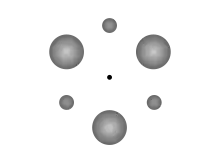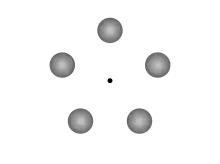Klemperer rosette
A Klemperer rosette is a gravitational system of heavier and lighter bodies orbiting in a regular repeating pattern around a common barycenter. It was first described by W. B. Klemperer in 1962,[1] and is a special case of a central configuration.

Klemperer described the system as follows:
Such symmetry is also possessed by a peculiar family of geometrical configurations which may be described as 'rosettes'. In these an even number of 'planets' of two (or more) kinds, one (or some) heavier than the other, but all of each set of equal mass, are placed at the corners of two (or more) interdigitating regular polygons so that the lighter and heavier ones alternate (or follow each other in a cyclic manner).
The simplest rosette would be a series of four alternating heavier and lighter bodies, 90 degrees from one another, in a rhombic configuration [Heavy, Light, Heavy, Light], where the two larger bodies have the same mass, and likewise the two smaller bodies have the same mass. The number of "mass types" can be increased, so long as the arrangement pattern is cyclic: e.g. [ 1,2,3 ... 1,2,3 ], [ 1,2,3,4,5 ... 1,2,3,4,5 ], [ 1,2,3,3,2,1 ... 1,2,3,3,2,1 ], etc.
Klemperer also mentioned octagonal and rhombic rosettes. While all Klemperer rosettes are vulnerable to destabilization, the hexagonal rosette has extra stability because the "planets" sit in each other's L4 and L5 Lagrangian points.
Misuse and misspelling

The term "Klemperer rosette" (often misspelled "Kemplerer rosette") is often used to mean a configuration of three or more equal masses, set at the points of an equilateral polygon and given an equal angular velocity about their center of mass. Klemperer does indeed mention this configuration at the start of his article, but only as an already known set of equilibrium systems before introducing the actual rosettes.
In Larry Niven's novel Ringworld, the Puppeteers' "Fleet of Worlds" is arranged in such a configuration (5 planets spaced at the points of a pentagon), which Niven calls a "Kemplerer rosette"; this (possibly intentional) misspelling (and misuse) is one possible source of this confusion. It is notable that these fictional planets were maintained in position by large engines in addition to gravitational force. Another is the similarity between Klemperer's name and that of Johannes Kepler, who described certain laws of planetary motion in the 17th century.
Instability
Simulations of this system[2] (or a simple linear perturbation analysis) demonstrate that such systems are unstable: any motion away from the perfect geometric configuration causes an oscillation, eventually leading to the disruption of the system (Klemperer's original article also states this fact). This is the case whether the center of the rosette is in free space, or itself in orbit around a star. The short-form reason is that any perturbation destroys the symmetry, which increases the perturbation, which further damages the symmetry, and so on.
The longer explanation is that any tangential perturbation brings a body closer to one neighbor and further from another; the gravitational imbalance becomes greater towards the closer neighbor and less for the farther neighbor, pulling the perturbed object further towards its closer neighbor, amplifying the perturbation rather than damping it. An inward radial perturbation causes the perturbed body to get closer to all other objects, increasing the force on the object and increasing its orbital velocity—which leads indirectly to a tangential perturbation and the argument above.
References
- Klemperer, W. B. (April 1962). "Some Properties of Rosette Configurations of Gravitating Bodies in Homographic Equilibrium". Astronomical Journal. 67 (3): 162–167. Bibcode:1962AJ.....67..162K. doi:10.1086/108686.
- Jenkins, Bob. "Klemperer Rosettes". Retrieved 2007-01-12.